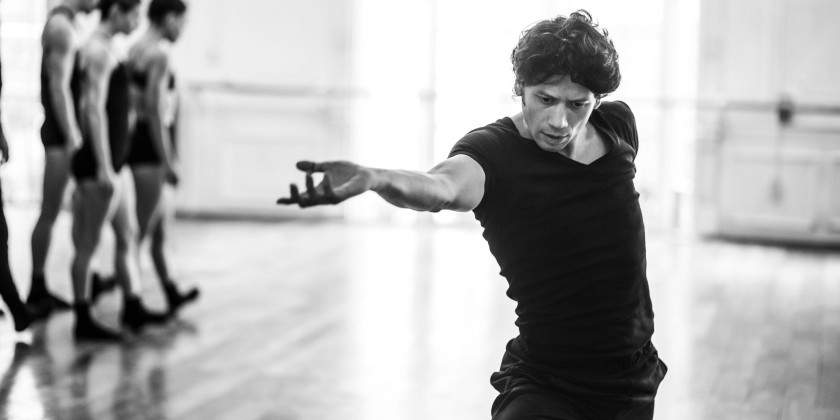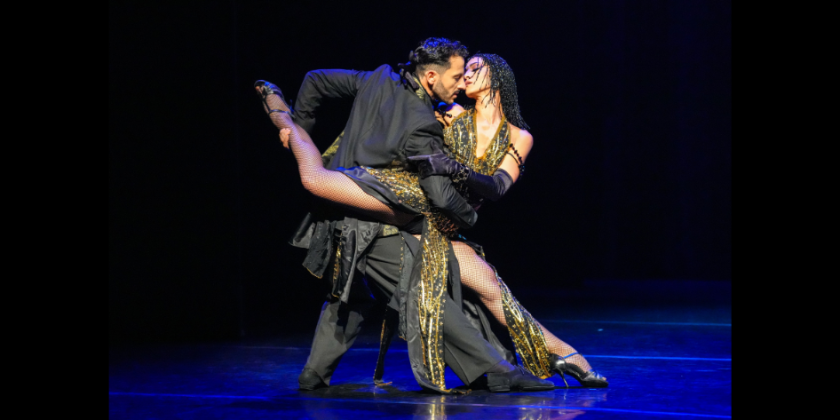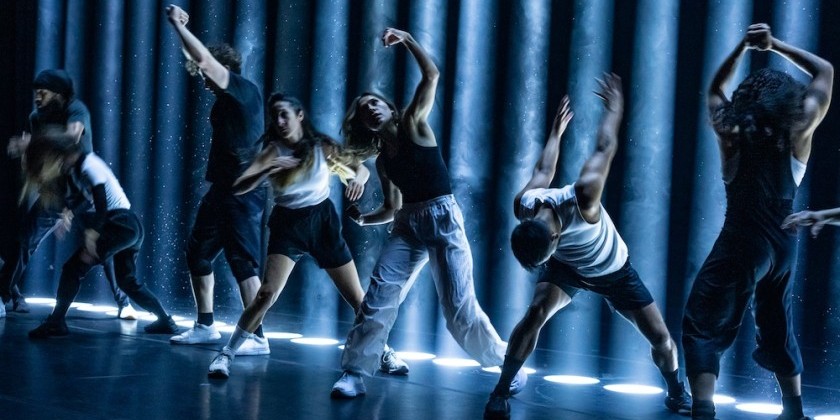Daniel Charon On The Alwin Nikolais Celebration at The Joyce

As The Ririe-Woodbury Dance Company Prepares to Share Nikolais' Genius
Alwin Nikolais Celebration
Danced by artists of the Ririe-Woodbury Dance Company
Under direction of Alberto del Saz
Repertory
Tensile Involvement (1955)
Gallery (1978)
Mechanical Organ III (1983)
Crucible (1985)
at The Joyce Theater
February 9-14, 2016
For tickets, go to The Joyce website
Dancing Alwin Nikolais’ choreography produces a kinetic rush. The range of movement qualities in their relation to time and space seem endless. Weight and flow, as incorporated from the Laban family tree of modern dance, and a practice called "graining" -- where the dancer directs their energy to a point of motion -- allow Nikolais' dancers to emphatically juxtapose softness with strong accented movement. But even if movement is the focal point for a dancer, other components of the theatrical world are equal players in the creations of Alwin Nikolais.
In his Gesamtkunstwerks this mastermind molds the abstraction of theatrical components such as motion, space, time, shape, color, light and sound, to – in the words of his long-time collaborator Ruth Grauert – “create a direct, sentient communication.” The dancer serves as the conduit.
While Nikolais’ critics speak of a dehumanization of the dancer, it is rather a decentralization, in which the dancer does not portray a character or emote personal feeling, but instead investigates and inhabits the many forms and movement qualities that the Nikolais' palette has to offer.
Alwin Nikolais was a choreographer and dancer, a lighting designer, a composer and musician, a stage director and designer. He was a master of the theater of the abstract and a trailblazer for the post-modernists. Four of his works are gracing the The Joyce Theater’s stage in New York City February 9 - 14, performed by Utah's Ririe-Woodbury Dance Company. I spoke with artistic director Daniel Charon, before the season.
Henning Rübsam
Henning Rübsam for The Dance Enthusiast: Hello, Daniel. Thanks for taking the time to chat. Tell me, what is the history of the Ririe- Woodbury Company's involvement with Alwin Nikolais' work?
Daniel Charon, Artistic Director of the Ririe-Woodbury Dance Company: Our founders, Joan Woodbury and Shirley Ririe worked closely with Alwin Nikolais and formed an early bond with him. He was the one who encouraged them to start their own company. Because of this relationship and deep history, Ririe-Woodbury is the only company granted the rights to perform full evenings of Nikolais’ work.
TDE: How was the repertory for this Joyce season determined?
Alberto Del Saz, the artistic director of the Nikolais/Louis Foundation for Dance, decided all the repertory performed. He is the mastermind behind preserving Nikolais’ legacy. The repertory that was ultimately chosen represents a variety of aesthetic sensibilities and also spans over 30 years. It includes a remarkable range from the haunting illusions found in Crucible to the pure dancing in Mechanical Organ. Each piece is a dramatically different representation of the range of Nikolais’ vast imagination.
TDE: Why is NIK's rep important to you?
DC: Since joining the Ririe-Woodbury Dance Company in 2013, this is the first time I have had the privilege to be involved in the restaging process of the Nikolais work. I’m fascinated with his development of the total dance theater – the way he envisioned the whole experience by creating the choreography and by designing the costumes, lights, scenery, and musical scores.
He did it all, and really was the first to work with mixed media to express his choreographic ideas. He was a pioneer and a visionary. As a choreographer, I use a lot of video in my own work so to see his dances makes me think deeply about how the relationship of multiple elements can create a unique experience or expression. He also uses some basic choreographic elements in simplistically brilliant ways which is a valuable reminder to me of the power of these structures.

TDE: What are the strengths of the Utah company?
DC: Ririe-Woodbury Dance Company was founded over 50 years ago upon a strong mission that still lies at the heart of what we do. This mission includes supporting the creation of new contemporary dance by commissioning multiple works each year. This keeps our repertory ever-changing to reflect the current trends in dance, and the world, as much as possible. It also supports the artists who create the work by giving them an opportunity to explore their craft.
Our mission supports a vigorous educational initiative that brings dance to thousands of school children annually. We believe that dance is for everybody and believe in it’s value to shape young people as artists and human beings. We realize this multi-faceted mission through the commitment and vision of a dedicated and talented staff including Jena Woodbury, Executive Director and Ai Fujii Nelson, Education Director.
We invest fully in the training, development, and nurturing of our six dancers that are employed full-time. It’s their versatility that enables us to transition from the classical works of Alwin Nikolais to the most recent commissioned choreography. We believe in the highest caliber of dancing possible to maintain and realize the full integrity of all of our repertory.
TDE: What was your role in the process for the season?
DC: The Nikolais work is staged by Alberto del Saz (Tito) with Joan Woodbury contributing. I am also involved in the restaging process and serve as a rehearsal director to this work. Because Tito lives in New York and is only in Salt Lake City at select times, I am here to maintain the integrity of the dances, rehearse the pieces, and even tech them, putting the work on stage from time to time. I cast the additional dancers (Ririe-Woodbury is six full time dancers but we hired four additional dancers for the Nikolais work) and work closely with Tito with any logistical or artistic decisions that need to be made.
TDE: Thanks so much for your time, any thoughts on your upcoming performances that you would like to share before we go?
DC: Nikolais' choreography continues to remain vibrant and relevant and still has the ability to inspire. It’s wonderful that the Nikolais/Louis Foundation of Dance looks to us as a partner in the keeping of this cherished work. This a very special, serious, and important aspect of organization.
Share Your Audience Review. Your Words Are Valuable to Dance.
Are you going to see this show, or have you seen it? Share "your" review here on The Dance Enthusiast. Your words are valuable. They help artists, educate audiences, and support the dance field in general. There is no need to be a professional critic. Just click through to our Audience Review Section and you will have the option to write free-form, or answer our helpful Enthusiast Review Questionnaire, or if you feel creative, even write a haiku review. So join the conversation.














